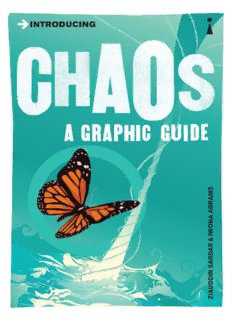
Introducing Chaos: A Graphic Guide PDF
Preview Introducing Chaos: A Graphic Guide
Published by Icon Books Ltd, Omnibus Business Centre, 39-41 North Road, London N7 9DP email: [email protected] www.introducingbooks.com ISBN: 978-184831-766-6 Text and illustrations copyright © 2013 Icon Books Ltd The author and artist have asserted their moral rights. Originating editor: Richard Appignanesi No part of this book may be reproduced in any form, or by any means, without prior permission in writing from the publisher. Contents Cover Title Page Copyright Yin, Yang and Chaos Ancient Chaos Chaos Theory Why is Chaos Exciting? Where Does Chaos Come From? Defining Chaos The Language of Chaos Dynamic, Change and Variable Systems Defining Systems Periodic and Aperiodic Equations What is Unstable Aperiodic Behaviour? Linear Systems Nonlinear Complication Feedback The Three Body Problem Chaos Modelling Questions of Long-Term Behaviour The Signature of Chaos The Little Devil Benoit Mandelbrot and Fractal Geometry Chaos and Order in Economics Chaos on the Telephone Lines Measuring the Coast Fractal Dimensionality What are Fractals? Fractals are Everywhere ... The Julia Set The Use of Fractals Edward Lorenz Small Differences, Big Consequences The Water Wheel Example Strange Attractors Cultural and Identity Attractors Chaotic Attractors Representing Phase Space Phase space makes a dynamic system easy to watch. The Lorenz Attractor The Butterfly Effect David Ruelle What is Turbulence? How Does Turbulence Happen? Ruelle’s Approach Robert May and Animal Populations May’s Bifurcations Chaos in Real-Life Events Mitchell Feigenbaum: Nonlinear Patterns Easy Solutions to Difficult Problems Ilya Prigogine: Dissipative Systems Disorder to Order Self-Organization and Time Time and the Problem of Entropy The Source of Order Other Features of Self-Organization Period Three Chaos Towards the Edge of Chaos: Complexity Theory What is Complexity? Adapt and Relate Beyond Entropy Chaotics Chaos and Cosmos Poincaré’s Discovery The Conditions of Stability Quasi-Periodic Stability The KAM Theorem Saturn’s Moons A Chaotic Universe Quantum Chaos Brief History of Quantum Theory The Black Body Problem Applying Planck’s Constant Probability Waves Chaos in Quantum Physics Chaos In Between States Chaos and Economics Feedback in Economics The Problems with Equilibrium Increasing Returns in High-Tech Beware of “Initial Conditions” The End of Neo-Classical Economics How to Play Monopoly Chaotic Management Anticipating Future Breakthroughs Enablement and Forecasting Chaos and Cities Fractal Cities Fractal Skylines Dissipative Cities Local and Global Chaos Control or Participation Chaotic Architecture Chaos and the Body Body Fractals The Heart’s Attractor Chaos in the Heart Chaos and Good Health Chaos and the Brain A Chaos Model of Consciousness Chaos and Weather Long-Term Weather Prediction What About the Greenhouse Effect? Chaos and Nature Scientific Safety The New Nature Is It Safe? Post-Normal Science Chaos and the Non-West Criticism of Chaos Further Reading Biographies Acknowledgements Index Yin, Yang and Chaos Ancient Chinese thought recognized that chaos and order are related. In Chinese myth, the dragon represents the principle of order, yang, which emerges from chaos. In some Chinese creation stories, a ray of pure light, yin, emerges out of chaos and builds the sky. Yin and yang, the female and male principles, act to create the universe. But even after they have emerged from chaos, yin and yang still retain the qualities of chaos. Too much of either brings back chaos. Ancient Chaos Hesiod, a Greek of the 8th century B.C., wrote the Theogony, a cosmological poem which states that “first of all Chaos came to be”, and then the Earth and everything stable. The ancient Greeks seem to have accepted that chaos precedes order, in other words, that order comes from disorder. Nothing further was made of this ‘mythical’ idea ... Until recently in the 20th century when chaos theory arrived. Chaos Theory Chaos theory is a new and exciting field of scientific inquiry. The phenomenon of chaos is an astounding and controversial discovery that most respectable scientists would have dismissed as fantasy just a decade or so ago. But today it is seen as one of the most notable since the advent of quantum theory in the early 1900s. If chaos theory fulfils its potential, it will dramatically change the way we view the natural world and ourselves.
Description: